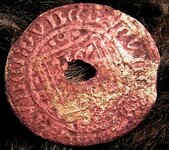BioProfessor
Silver Member
Well, here is a first report on Metal Detecting in the Netherlands. It is WAY different from what I am used to and know how to do. About the only way I'm going to find much is if people throw it at me and I pick it up. I'm not sure if I can do it "Their Way."
I am used to taking my detector to an area and searching probable sites for "good" signals. If the signal warrants it, I dig whatever is causing it and see what I have found. So I am used to searching, getting a good signal, and digging it out. Over here, it is backwards. The land has been sinking for centuries and is still sinking. Many places have had new soil added to them or floods have deposited new soil to the area. There are also no old homesites to hunt. The family is still living in the house built in the 16th century and they don't plan on going anywhere. There are no groves around the farm fields. They butt right up against each other. The crops are in this time of year so I can't walk any plowed fields looking for stuff that has come to the surface.
So what you have to do is look for a piece of ground where something has been torn down. There is no room between houses to search in the cities so the only way ground is exposed is if the house is torn down. In places outside of town, new development opens up new ground to be searched. Once you find this patch of new ground, you have to dig you out a place. Most people like to dig a hole about 3 feet wide and 3-5 feet deep. This removes all the "new" dirt and gets you down to the dirt that was on top of the ground in and around the 16th century. You have no clue if there is anything there because you have no clue as to what may have been there 500 years ago. So you are guided by instinct and luck. Once you have the hole cleaned out, you then start taking out shovel fulls of wet, sticky, clay and try to get it off your shovel. If you can, you then spread out several shovel fulls and then use your metal detector to see if there is anything there. The condition of the soil is such that it limits your metal detector to about half or less of its normal depth so you have to spread out the sticky mess no more than 3 inches thick. Usually there is nothing there, so you take your shovel and remove this clay and dig some more, spread it out and use your detector again. Talking about hard work. Man, it is a killer. Three to four hours of this and you are done. A pretty hard way to try and find something.
You do this in different places and hope you happen upon something somebody dropped centuries ago. Or if you are EXTREMELY lucky, you find the site of an old home or camp. Something where the odds of having something to find are much greater but good luck find this kind of place.
Tot lots are way different here as well. There is no sand or wood chips. The ground is covered in either concrete or brick pavers. No cushioning here if you fall. I guess there aren't as many liability laws. So to search a tot lot is like searching a parking lot. Not much chance of anybody losing anything or you finding anything.
Volleyball courts here are different as well. They put them in parks but not in permanent area. They just decide a place looks good for a court this year and they put about an inch of sand on the grass, put up some nets, and that is the volleyball area for the year. Not easy to lose something in an inch or less of sand. So not much use in detecting there.
I have been to several places that are actively being dug and have found 2 coins in 3 weeks. No modern coins at these places so I can't even count on battery or tram money.
So far I have found an 1869 2 1/2 silver Guilder and a French Jetton (coin-like token used when people didn't know how to count to exchange money for goods. Used sort of like an abacus with the Jettons being the beads and the abacus strings being groves in a table). The Jetton is from the 15th century and like most of them from that period, someone has punched a hole in it. They don't know why this was done. Some people speculate that when people learned to count, the Jettons were worthless and there were a lot of them and they were used as decorations on things. Just nailed up as a way to "pretty up" something. Oh, and by the way. They are worthless now as well. The 2 1/2 Guilder is worth about 15 dollars. Pretty much the going rate for silver. Just not old enough or rare enough. Makes clad look like a gold mine.
Anyway, I'm on lots of Tylenol and can't get too motivated to go dig in 4 foot hole full of muck that may or may not hold anything.
Just be glad you don't have to do it this way. It's a pretty crappy way to try and find something.
Daryl
I am used to taking my detector to an area and searching probable sites for "good" signals. If the signal warrants it, I dig whatever is causing it and see what I have found. So I am used to searching, getting a good signal, and digging it out. Over here, it is backwards. The land has been sinking for centuries and is still sinking. Many places have had new soil added to them or floods have deposited new soil to the area. There are also no old homesites to hunt. The family is still living in the house built in the 16th century and they don't plan on going anywhere. There are no groves around the farm fields. They butt right up against each other. The crops are in this time of year so I can't walk any plowed fields looking for stuff that has come to the surface.
So what you have to do is look for a piece of ground where something has been torn down. There is no room between houses to search in the cities so the only way ground is exposed is if the house is torn down. In places outside of town, new development opens up new ground to be searched. Once you find this patch of new ground, you have to dig you out a place. Most people like to dig a hole about 3 feet wide and 3-5 feet deep. This removes all the "new" dirt and gets you down to the dirt that was on top of the ground in and around the 16th century. You have no clue if there is anything there because you have no clue as to what may have been there 500 years ago. So you are guided by instinct and luck. Once you have the hole cleaned out, you then start taking out shovel fulls of wet, sticky, clay and try to get it off your shovel. If you can, you then spread out several shovel fulls and then use your metal detector to see if there is anything there. The condition of the soil is such that it limits your metal detector to about half or less of its normal depth so you have to spread out the sticky mess no more than 3 inches thick. Usually there is nothing there, so you take your shovel and remove this clay and dig some more, spread it out and use your detector again. Talking about hard work. Man, it is a killer. Three to four hours of this and you are done. A pretty hard way to try and find something.
You do this in different places and hope you happen upon something somebody dropped centuries ago. Or if you are EXTREMELY lucky, you find the site of an old home or camp. Something where the odds of having something to find are much greater but good luck find this kind of place.
Tot lots are way different here as well. There is no sand or wood chips. The ground is covered in either concrete or brick pavers. No cushioning here if you fall. I guess there aren't as many liability laws. So to search a tot lot is like searching a parking lot. Not much chance of anybody losing anything or you finding anything.
Volleyball courts here are different as well. They put them in parks but not in permanent area. They just decide a place looks good for a court this year and they put about an inch of sand on the grass, put up some nets, and that is the volleyball area for the year. Not easy to lose something in an inch or less of sand. So not much use in detecting there.
I have been to several places that are actively being dug and have found 2 coins in 3 weeks. No modern coins at these places so I can't even count on battery or tram money.
So far I have found an 1869 2 1/2 silver Guilder and a French Jetton (coin-like token used when people didn't know how to count to exchange money for goods. Used sort of like an abacus with the Jettons being the beads and the abacus strings being groves in a table). The Jetton is from the 15th century and like most of them from that period, someone has punched a hole in it. They don't know why this was done. Some people speculate that when people learned to count, the Jettons were worthless and there were a lot of them and they were used as decorations on things. Just nailed up as a way to "pretty up" something. Oh, and by the way. They are worthless now as well. The 2 1/2 Guilder is worth about 15 dollars. Pretty much the going rate for silver. Just not old enough or rare enough. Makes clad look like a gold mine.
Anyway, I'm on lots of Tylenol and can't get too motivated to go dig in 4 foot hole full of muck that may or may not hold anything.
Just be glad you don't have to do it this way. It's a pretty crappy way to try and find something.
Daryl
Attachments
Upvote
0





 I doubt I could tolerate that kind of MDing either. Sounds too much like work. Congrats of what you have found so far. Again, great post.
I doubt I could tolerate that kind of MDing either. Sounds too much like work. Congrats of what you have found so far. Again, great post. -
-

